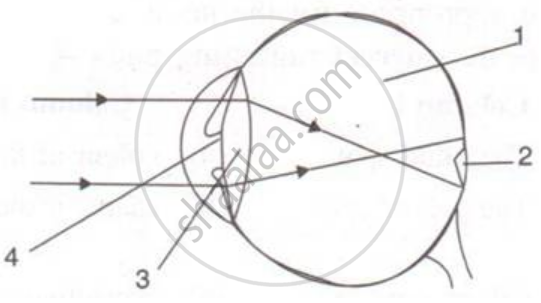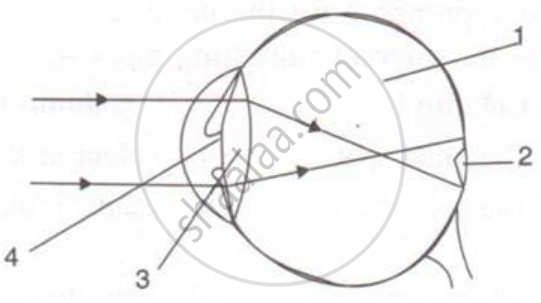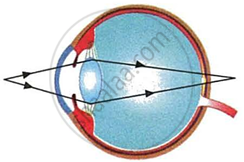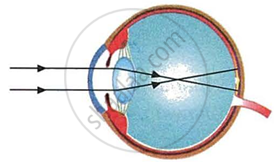Advertisements
Advertisements
प्रश्न
In Myopia the human eye _______.
पर्याय
cannot see nearby objects distinctly
cannot see distant objects clearly
cannot see nearby as well as distant objects clearly
can see nearby as well as distant objects clearly
उत्तर
In Myopia the human eye cannot see distant objects clearly.
संबंधित प्रश्न
Millions of people in the developing countries of the world are suffering from corneal blindness. These persons can be cured by replacing the defective cornea with the cornea of a donated eye. A charitable society of your city has organised a campaign in your neighbourhood in order to create awareness about this fact. If you are asked to participate in this mission, how would you contribute in this noble cause?
(i) State the objective of organising such campaigns.
(ii) List two arguments which you would give to motivate the people to donate their eyes after death.
(iii) List two values which are developed in the persons who actively participate and contribute in such programmes.
A student is unable to see clearly the words written on the blackboard placed at a distance of approximately 4 m from him. Name the defect of vision the boy is suffering from. Explain the method of correcting this defect.
Draw ray diagram for the:-
(i) defect of vision and also
(ii) for its correction.
List three common refractive defects of vision. Suggest the way of correcting these defects.
The kind of lens required to correct Myopia
What is the scientific name of
short-sightedness
Name one defect of vision (or eye) which cannot be corrected by any type of spectacle lenses.
A man can read the number of a distant but clearly but he finds difficulty in reading a book.
What type of spectacle lens should he use to correct the defect?
A student sitting in the last row of the class-room is not able to read clearly the writing on the blackboard.
How can this defect by corrected?
What is short-sightedness? State the two causes of short-sightedness (or myopia). With the help of ray diagrams, show:
(i) the eye-defect short-sightedness.
(ii) correction of short-sightedness by using a lens.
An eye has a far point of 2 m. What type of lens in spectacles would be needed to increase the far point to infinity? Also calculate the power of lens required. Is this eye long-sighted or short-sighted?
The picture given here shows a person wearing 'half-moon' spectacles. What sort of eye-defect do do you think he has? Why are these particular spectacles useful to him?
The near point of a long-sighted person is 50 cm from the eye.
(a) Can she see clearly an object at:
(i) a distance of 20 cm?
(ii) at infinity?
To read a book held at a distance of 25 cm, will she need converging or diverging spectacle lenses?
A person can read a book clearly only if he holds it at an arm's length from him. Name the defect of vision:
if the person is an old man
A person can read a book clearly only if he holds it at an arm's length from him. Name the defect of vision:
if the person is a young man
Name the following:
The eye defect caused due to shortening of the eye ball from front to back.
Have a look at the posture of this girl who is reading a book and answer the questions which follow:

Name the problem she is facing.
What eye defect is hypermetropia? Describe with a ray diagram how this defect of vision can be corrected by using an appropriate lens.
List two causes of presbyopia. Draw labelled diagram of a lens used for the correction of this defect of vision.
When do we consider a student sitting in the class to be myopic? List two causes of this defect. Explain using a ray diagram how this defect of eye can be corrected.
Name the following:
The photosensitive pigment present in the rod cells of the retina.
Select the odd one in the following series:
Endolymph, Tympanic membrane, Semi-circular canal, Blind spot.
Given below is a diagram depicting a defect of the human eye? Study the same and answer the question that follow:

Give two possible reasons for this defect of the eye in human beings.
Given below is a diagram depicting a defect of the human eye? Study the same and answer the question that follow :

Name the type of lens used to correct this eye defect.
Rewrite the following table so as to match second and third column with first column.
|
Column I
|
Column II
|
Column III
|
|
(i) Myopia
|
Old age problem
|
Bifocal lens
|
|
(ii) Presbyopia
|
Nearsightedness
|
Concave lens.
|
Anuja cannot see the blackboard writing but she can see nearby things.
(a) What is the eye defect she is suffering from?
(b) State the possible reason for her defect.
(c) How is it corrected
Give Reason:
Why do we see clearly in the central region of the retina?
Differentiate between:
Myopia and Hypermetropia.
Given below is a diagrammatic representation of a defect of the human eye:

(i) Identify the defect.
(ii) Mention two reasons for the above defect.
(iii) State how the defect can be rectified.
(iv) Name the part of the eye responsible for maintaining the shape of the eyeball.
Write scientific reason.
Nearsightedness, this defect can be corrected by using spectacles with concave lens.
Observe the given below the figure, correct it and explain and write about the concept depicted in this figure.

Which of the following statement is correct?
Draw ray diagram showing myopic eye.
A person needs a lens of power –4.5 D for correction of her vision.
- What kind of defect in vision is she suffering from?
- What is the focal length of the corrective lens?
- What is the nature of the corrective lens?
State reasons for Myopia. With the help of ray diagrams, show the:
- image formation by a myopic eye, and
- correction of myopia using an appropriate lens.
Name the following:
Two kinds of accomodations.
Have a look at the posture of this girl who is reading a book and answer the questions which follow:
 |
- Name the problem she is facing.
- What are the two conditions shown in sections A and B of the eye as applicable to her.
- What kind of reading glasses does she need?
 |
 |
| A | B |
